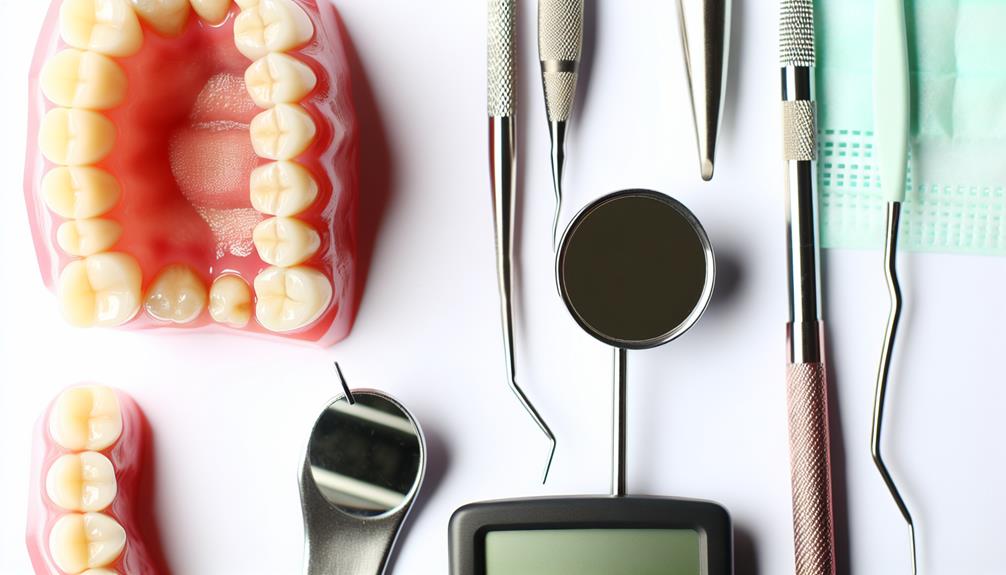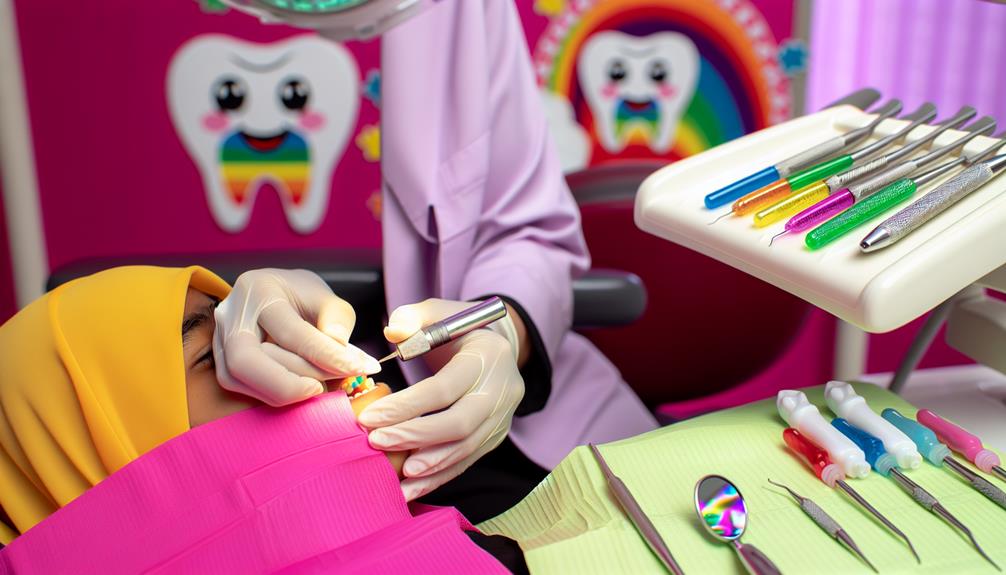Gum disease treatment costs vary considerably based on the procedure's complexity and location. Non-surgical options like scaling and root planing typically range from $200 to $400 per quadrant, while surgical interventions can cost between $1,000 and $3,000. Ongoing maintenance therapy costs approximately $75 to $250 per session. Insurance coverage may be limited, often covering preventive care but not advanced treatments. Various financing options are available to manage out-of-pocket costs effectively. Understanding these factors guarantees informed decisions for oral health, emphasizing the importance of preventative care in reducing long-term expenses and maintaining overall well-being. Further insights can provide clarity on your options.
Key Takeaways
- Periodontal treatments vary in cost, with scaling and root planing ranging from $200 to $400 per quadrant based on disease severity.
- Surgical interventions can cost between $1,000 to $3,000, depending on the complexity of the procedure.
- Regular maintenance therapy typically costs between $75 and $250 per session to prevent gum disease recurrence.
- Insurance coverage can be limited; patients should review their policies for specifics on coverage and out-of-pocket expenses.
- Flexible financing options, including payment plans and HSAs, can help manage treatment costs effectively.
Understanding Gum Disease

Gum disease, clinically known as periodontal disease, is a prevalent oral health condition characterized by inflammation and infection of the supporting structures of the teeth, including the gums, periodontal ligaments, and alveolar bone. The primary causative factor is the accumulation of dental plaque, a sticky film of bacteria that, if not regularly removed through proper oral hygiene practices, can lead to gingivitis and, subsequently, more severe forms of periodontal disease. Chronic stress can also contribute to the deterioration of gum health by weakening the immune system, making it harder for the body to combat infections, including those in the mouth how stress impacts health.
Symptoms awareness is essential for effective gum disease prevention. Common indicators include swollen or bleeding gums, persistent bad breath, and gum recession. Early detection is critical, as the condition can progress without noticeable symptoms, potentially resulting in tooth loss and systemic health issues.
Preventive measures are foundational in combating gum disease. Regular dental check-ups, professional cleanings, and a consistent oral hygiene routine, including brushing and flossing, can greatly reduce the risk of developing periodontal disease. Educating oneself and others about the importance of gum health fosters a community that prioritizes oral hygiene, ultimately leading to healthier smiles and improved overall well-being.
Types of Periodontal Treatments
Periodontal treatments are categorized into non-surgical and surgical interventions, each tailored to address varying degrees of gum disease. Non-surgical options often focus on scaling and root planing, which can be essential for initial healing and reducing inflammation. Understanding the emotional challenges associated with health issues can be beneficial; for instance, navigating grief during a health crisis can impact recovery. Surgical procedures may include flap surgery or bone grafts for advanced cases. Additionally, ongoing maintenance and follow-up care are crucial to guarantee the long-term health of periodontal tissues following initial treatment.
Non-Surgical Treatments
Effective management of periodontal disease often begins with non-surgical treatments, which focus on reducing inflammation and promoting the health of supporting structures around the teeth. These interventions are typically aimed at reversing the early stages of gum disease and preventing its progression. Among the most common non-surgical methods are scaling and root planing, often referred to as deep cleaning. This process removes plaque and tartar from above and below the gum line, addressing the root causes of periodontal disease.
The scaling benefits include:
- Reduction of Bacterial Load: Eliminating harmful bacteria that contribute to inflammation.
- Improved Gum Health: Promoting the reattachment of gum tissue to the teeth, leading to healthier gums.
- Prevention of Tooth Loss: Addressing gingival issues before they escalate into more severe conditions.
In addition to scaling and root planing, adjunctive therapies such as antimicrobial agents and localized delivery systems may also be employed to enhance treatment outcomes. Understanding these non-surgical options is crucial for patients seeking to maintain their oral health and prevent the complications associated with periodontal disease.
Surgical Procedures
When non-surgical treatments are insufficient to manage advanced periodontal disease, surgical procedures may become necessary to restore oral health. These interventions are designed to reduce periodontal pockets, regenerate lost tissue, and improve the overall structure of the supporting bone.
One common surgical option is flap surgery, which involves lifting the gums away from the teeth to access the underlying bone and tissue. This approach allows for thorough cleaning of the roots and the removal of infected tissue. After the procedure, the gums are repositioned and sutured securely to promote healing.
In cases where significant bone loss has occurred, bone grafting techniques may be employed. This procedure involves placing bone material—either from the patient, a donor, or synthetic sources—into areas where the bone has deteriorated. This graft serves as a scaffold for new bone growth, ultimately enhancing the stability of the teeth and supporting structures.
Both flap surgery options and bone grafting techniques are critical components of effective periodontal treatment, aiming to halt disease progression and restore function, ultimately fostering a healthier and more confident smile.
Maintenance and Follow-Up
Ongoing maintenance and follow-up care are essential components of successful periodontal treatment, ensuring that patients maintain ideal oral health post-intervention. After initial treatments such as scaling, root planing, or surgical procedures, a structured maintenance program is critical. This program typically includes regular dental visits and personalized home care strategies designed to prevent disease recurrence.
To achieve best outcomes, patients should focus on the following:
- Routine Professional Cleanings: Regular appointments with a dental professional help remove plaque and tartar that at-home care may miss.
- Home Care Practices: Effective brushing, flossing, and the use of antimicrobial mouth rinses are important for maintaining gum health.
- Lifestyle Changes: Modifications such as quitting smoking and improving dietary choices can greatly impact periodontal stability.
Factors Affecting Treatment Costs

The cost of periodontal treatment is influenced by a variety of factors that can greatly impact both the patient's financial commitment and the overall treatment plan. One significant aspect is the treatment location, as urban centers often have higher costs compared to rural areas. Provider experience also plays an essential role; seasoned practitioners may charge more due to their expertise and successful outcomes. Additionally, many retirees are exploring flexible job options to supplement their income, which can help manage these expenses stress-free job ideas.
Patient age is another consideration, as older individuals might require more complex procedures, increasing costs. Additionally, advancements in dental technology can lead to variations in pricing. Cutting-edge tools may enhance treatment effectiveness but often come at a premium.
Geographic region further influences costs, with certain areas having higher living expenses, which translates to more expensive dental care. Treatment urgency can also affect pricing; immediate care often incurs higher fees due to the need for expedited services. Finally, a patient's overall health can complicate treatment, necessitating more extensive interventions, ultimately raising expenses. Understanding these factors allows patients to make informed decisions regarding their periodontal care and financial planning.
Average Costs of Procedures
Various periodontal procedures come with distinct average costs, reflecting the complexity and specific requirements of each treatment. Understanding the average pricing can help patients make informed decisions while considering their oral health needs. Currency conversion rates may also play a role in how patients budget for these treatments if they are traveling or seeking care in different countries. Cost comparisons across various procedures may reveal significant differences, influencing treatment choices.
The following are average costs associated with common periodontal procedures:
- Scaling and Root Planing: Typically ranges from $200 to $400 per quadrant, depending on the severity of gum disease.
- Periodontal Surgery: Average pricing can vary widely, from $1,000 to $3,000, based on the extent of the intervention required.
- Maintenance Therapy: Regular maintenance visits may cost between $75 and $250 per session, aimed at preventing disease recurrence.
These figures emphasize the importance of obtaining detailed quotes from dental professionals to understand the full scope of expenses involved. As costs can differ by location and individual circumstances, patients are encouraged to seek personalized estimates. This knowledge can empower individuals to prioritize their periodontal care effectively while ensuring they are part of a community that values oral health.
Insurance Coverage for Treatments

Steering through insurance coverage for periodontal treatments can be a complex process, yet it is essential for managing the financial burden of oral health care. Many dental insurance plans offer varying degrees of coverage for periodontal procedures, but understanding the specifics is critical for patients seeking treatment. As with any significant health-related expense, maneuvering the emotional aspects of financial decisions—like those during job changes—can also play a role in how patients approach their oral health care maneuvering the emotional journey.
Insurance limitations often dictate the extent of coverage, with many plans providing benefits for preventive care, such as cleanings, while offering reduced coverage for more advanced treatments like scaling and root planing or surgical interventions. Additionally, it is important to be aware of coverage exclusions that may apply, as certain procedures could be deemed cosmetic or unnecessary under specific policies.
Patients should carefully review their insurance policy documents and consult with their dental provider to clarify what is covered and what costs may need to be borne out-of-pocket. This proactive approach not only helps in anticipating expenses but also fosters a sense of empowerment in maneuvering one's oral health journey. Ultimately, understanding insurance coverage for periodontal treatments is an essential step in ensuring that patients can access the care they need while minimizing financial stress.
Payment Options and Plans
Understanding insurance coverage is only one part of managing the financial aspects of periodontal care; exploring payment options and plans is equally important. Many dental practices offer flexible financing options to help patients afford necessary treatments without undue financial strain. Understanding these options can empower patients to prioritize their oral health.
When considering payment plans, it is essential to evaluate what each practice offers, as this can vary considerably. Patients may find the following options beneficial:
- In-house financing: Many dental offices provide tailored payment plans that allow for monthly installments based on the patient's financial situation.
- Third-party financing: Companies like CareCredit offer loans specifically for healthcare expenses, often with promotional interest rates.
- Sliding scale fees: Some practices may adjust fees based on income, making it more accessible for patients with financial constraints.
Managing Out-of-Pocket Expenses

Managing out-of-pocket expenses for periodontal care requires careful planning and awareness of potential costs. Patients should begin by developing effective budgeting strategies tailored to their specific treatment needs. Evaluating the total anticipated expenses, including consultations, diagnostic tests, and various treatment options, is vital in creating a realistic financial plan.
It is advisable to communicate openly with dental care providers about costs associated with periodontal treatments. Many practitioners can provide cost estimates and discuss financing options, enabling patients to make informed decisions. In addition, exploring financial assistance programs offered by dental organizations or non-profits can alleviate some of the financial burdens.
Patients should also consider utilizing Health Savings Accounts (HSAs) or Flexible Spending Accounts (FSAs) if available, as these can provide tax advantages when paying for medical expenses. Moreover, keeping track of all expenses related to periodontal care can help in evaluating budgets and managing costs effectively.
Importance of Preventive Care
Preventive care in periodontal health is essential for the early detection of potential issues, greatly reducing the risk of advanced disease. Implementing cost-effective maintenance strategies not only enhances patient outcomes but also minimizes long-term expenses associated with more intensive treatments. Consequently, prioritizing preventive measures can lead to substantial benefits for both patients and healthcare providers.
Early Detection Benefits
Early detection of periodontal disease can greatly reduce treatment costs and improve long-term oral health outcomes. By fostering symptom awareness and encouraging early intervention, individuals can prevent the progression of disease, ultimately saving time and financial resources. Regular dental check-ups and vigilant self-monitoring are essential components of effective preventive care.
The benefits of early detection include:
- Reduced Treatment Complexity: Addressing periodontal issues at their onset minimizes the need for invasive procedures later on.
- Lower Financial Burden: Early intervention typically incurs lower costs than treating advanced gum disease, which may involve surgery or extensive restorative work.
- Enhanced Quality of Life: Maintaining ideal gum health can lead to improved overall health and well-being, positively affecting daily functioning and self-esteem.
Cost-Effective Maintenance Strategies
Effective maintenance strategies in periodontal care are crucial for sustaining oral health and minimizing long-term costs. By adopting a proactive approach, patients can greatly reduce the likelihood of advanced gum disease, which often results in costly treatments.
Key strategies include:
| Strategy | Description | Benefits |
|---|---|---|
| Home Remedies | Natural solutions for gum care | Reduced inflammation and improved healing |
| Diet Modifications | Nutritional support for gum health | Strengthened immune response and tissue repair |
| Regular Checkups | Professional assessments and cleanings | Early detection of potential issues |
Incorporating robust oral hygiene practices, such as daily brushing and flossing, is crucial. Patient education empowers individuals to make informed decisions about lifestyle changes, including smoking cessation and stress management. Additionally, herbal supplements can provide adjunctive benefits when used alongside conventional treatments. By focusing on these cost-effective strategies, patients can foster a supportive community around their oral health while greatly reducing future treatment costs. Ultimately, investing in preventive care through consistent practices guarantees a healthier, more confident smile for years to come.
Frequently Asked Questions
How Can I Tell if I Have Gum Disease?
To determine if you have gum disease, be vigilant for common gum disease symptoms such as persistent bad breath, swollen or bleeding gums, and changes in tooth alignment. Regular dental check-ups are crucial for evaluating your periodontal health, as early detection can prevent progression. Additionally, observe any receding gums or increased tooth sensitivity, as these may indicate underlying issues. Prompt attention to these signs is essential for maintaining ideal oral health.
Are There Natural Remedies for Gum Disease?
Natural remedies for gum disease may include several approaches. Herbal rinses, such as those containing chamomile or sage, can help reduce inflammation. Oil pulling with coconut oil is another technique that may promote oral health. Additionally, dietary changes emphasizing anti-inflammatory foods, such as fruits and vegetables, can support gum health. Incorporating vitamin supplements, particularly vitamin C and D, may also contribute to improving overall periodontal wellness. Always consult with a healthcare professional before starting any treatment.
What Should I Expect During a Periodontal Exam?
During a periodontal exam, you can expect a detailed periodontal assessment focused on evaluating your gum health. The dentist or periodontist will examine your gums for signs of inflammation, measure pocket depths around each tooth, and assess any bone loss. X-rays may be taken to identify underlying issues. This thorough evaluation will help determine the presence of periodontal disease and guide subsequent treatment options, ensuring ideal gum health and overall oral hygiene.
Can Gum Disease Affect My Overall Health?
Gum disease, also known as periodontal disease, can greatly impact overall health. Research indicates a correlation between gum disease and various systemic conditions, including cardiovascular disease, diabetes, and respiratory issues. The inflammatory response associated with periodontal disease may exacerbate these health problems, leading to more severe outcomes. As a result, maintaining ideal oral hygiene and seeking regular dental care are essential not only for oral health but also for the prevention of potential systemic complications.
Is Gum Disease Treatment Painful or Uncomfortable?
Gum disease treatment can vary regarding discomfort, but effective pain management strategies are typically employed. Options such as local anesthesia, sedation, and post-procedure analgesics are available to minimize any potential pain during and after treatment. The level of discomfort largely depends on the severity of the condition and the specific treatment options chosen. Discussing concerns with your dental professional can help guarantee a more comfortable experience throughout the treatment process.





